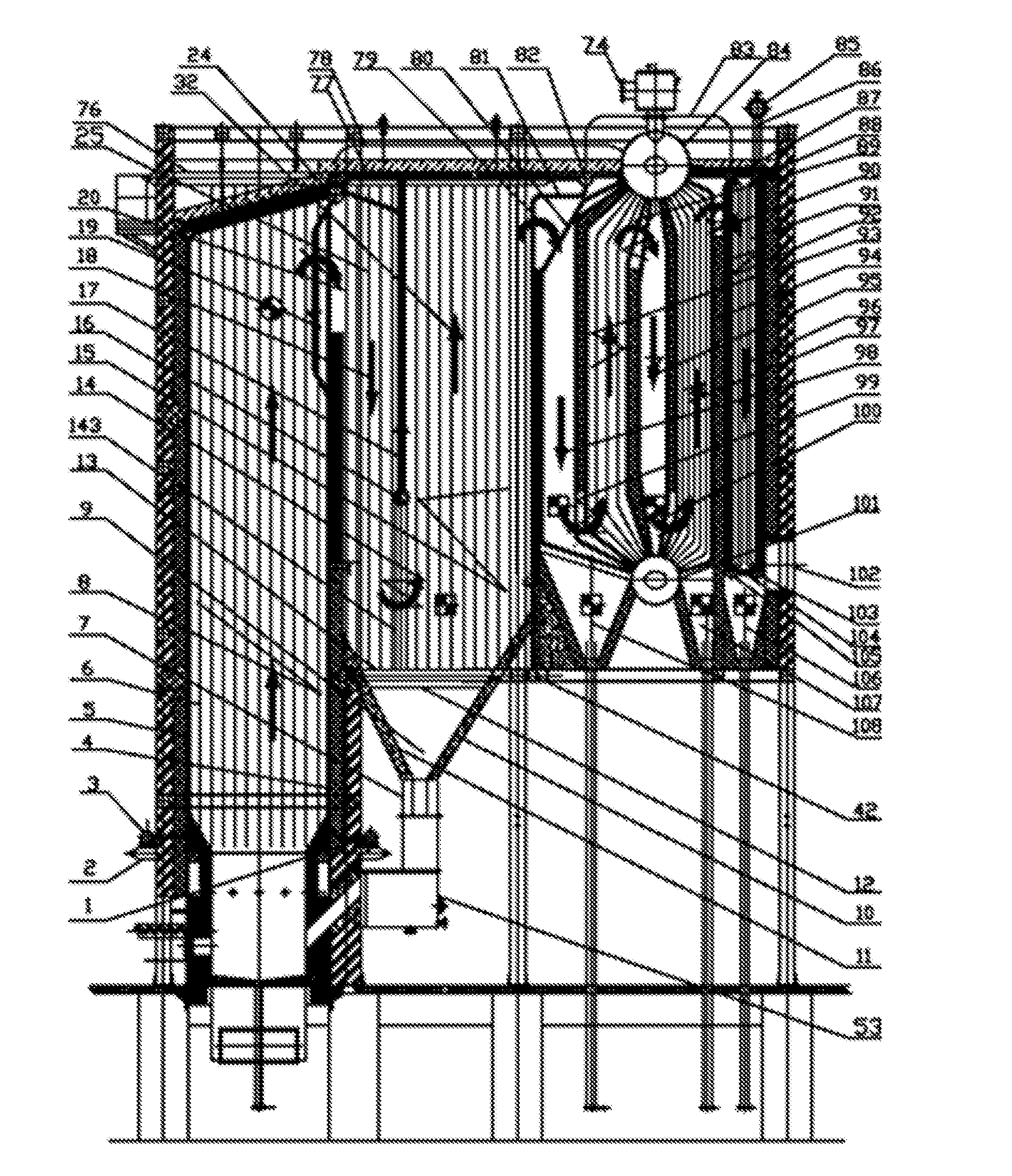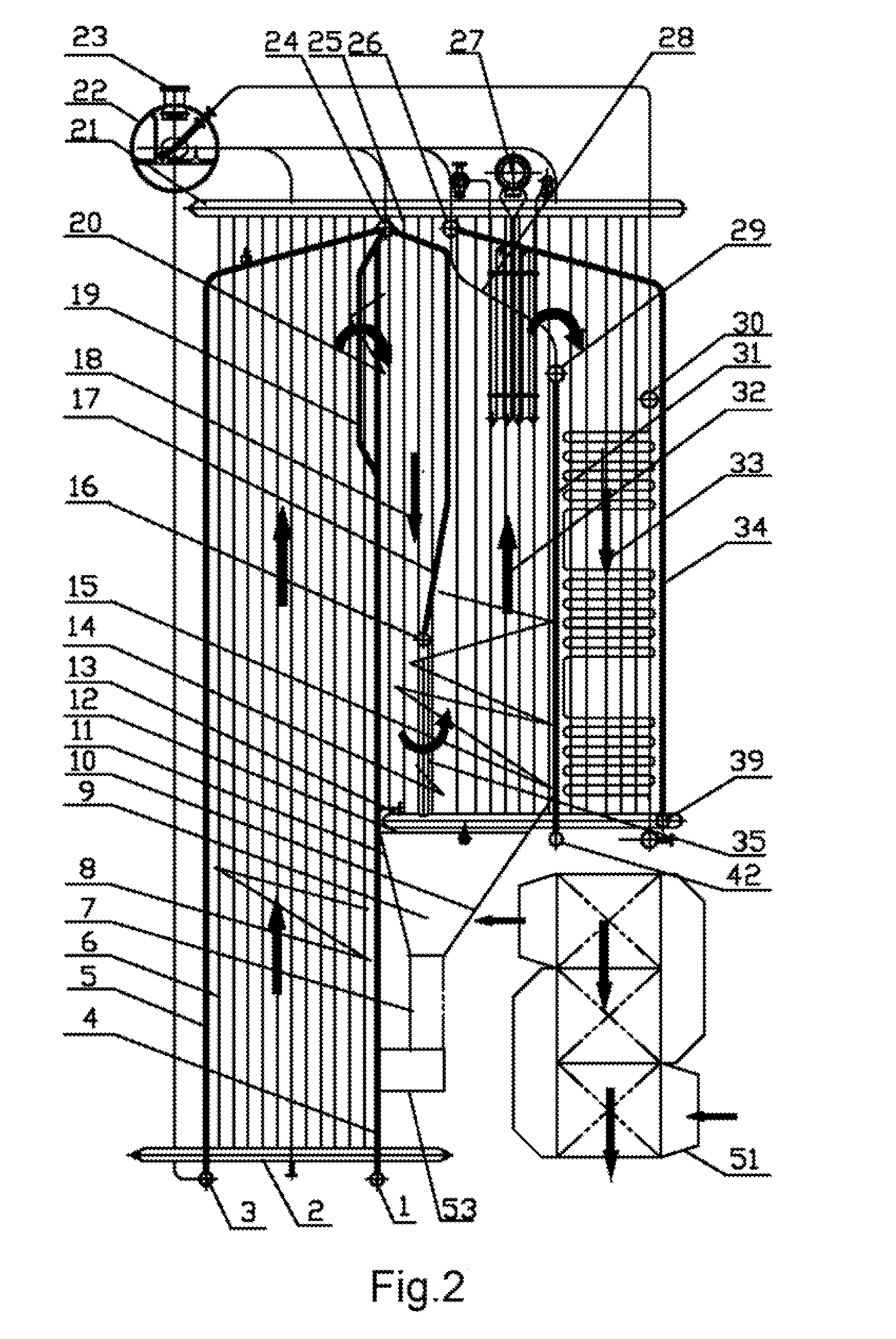Fluidized-bed boiler integrating multifunctional inertia-gravity separator with multiple furnace profiles
a technology of inertia-gravity separator and fluidized bed, which is applied in the direction of fluidized bed combustion apparatus, lighting and heating apparatus, combustion types, etc., to achieve the effect of reducing the emission of other pollutants, improving the efficiency of desulfurization and denitrition, and fume velocity at the inlet end
- Summary
- Abstract
- Description
- Claims
- Application Information
AI Technical Summary
Benefits of technology
Problems solved by technology
Method used
Image
Examples
embodiment 1
[0299]Referring to FIG. 1, a fluidized-bed boiler integrating a multifunctional inertia-gravity separator and a plurality of models of boilers is a circulating fluidized-bed boiler having a full-membrane-wall or full-water-cooling hearth, a full-water-cooling separator, a full-water-cooling shaft and a full-water-cooling ceiling.
[0300]A primary high-temperature water-cooling inertia-gravity separator is disposed in a space from the rear wall 4 of the hearth to the front wall 31 of the shaft. The front wall of the separator is completely the rear wall 4 of the hearth, and the rear wall 31 of the separator and the oblique transition segment 36 of the rear wall of the large capacity-capacity-expanding space share a wall with the front wall of the shaft. A guiding gas-solid directly-raising storage bin water-cooling wall 17 is disposed in the middle or slightly anterior or more anterior of a space between the front wall and the rear wall of the separator and is divided into a downward f...
embodiment 2
[0311]Referring to FIG. 2, the difference between this embodiment and Embodiment 1 is mainly the single-stage water-cooling inertia-gravity separator, the lower end of the vertical segment of the tube bundle on the rear wall 31 of which is communicated to the lower horizontal header 42 on the rear wall of the separator.)
embodiment 3
[0312]Referring to FIG. 3, the difference between this embodiment and Embodiment 2 is mainly that the convectional heater face of the shell shaft 58 is a threaded flue tube 59; the upper tube plate 57 of the shell is communicated to the lower end of the communicating tube 56 while the upper end thereof is communicated to the horizontal header 55; the upper end of the horizontal header 55 is communicated to the lower end of the communicating tube 54; the upper end of the communicating tube 54 is bent forward and upward and obliquely extended to be communicated to the horizontal header 26 and to form the water-cooling ceilings of both the upward flue 32 of the separator and the shell shaft; the rear end of the horizontal header 55 is vertical to, parallel to or exceeds the rear end of the shell shaft 58 by a certain distance to meet the requirement of constructing the rear wall of the shaft; and the distance from the lower end of the horizontal header 55 to the upper tube plate 57 of ...
PUM
 Login to View More
Login to View More Abstract
Description
Claims
Application Information
 Login to View More
Login to View More - R&D
- Intellectual Property
- Life Sciences
- Materials
- Tech Scout
- Unparalleled Data Quality
- Higher Quality Content
- 60% Fewer Hallucinations
Browse by: Latest US Patents, China's latest patents, Technical Efficacy Thesaurus, Application Domain, Technology Topic, Popular Technical Reports.
© 2025 PatSnap. All rights reserved.Legal|Privacy policy|Modern Slavery Act Transparency Statement|Sitemap|About US| Contact US: help@patsnap.com



